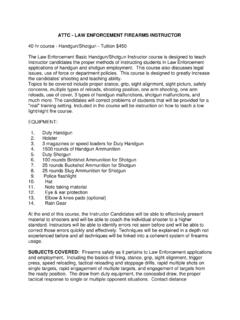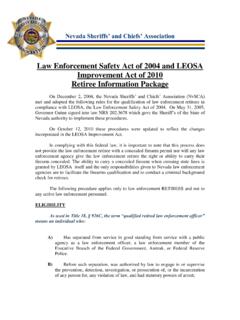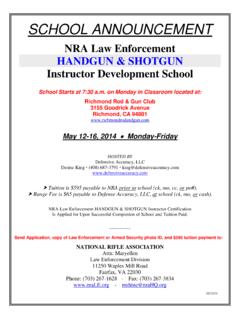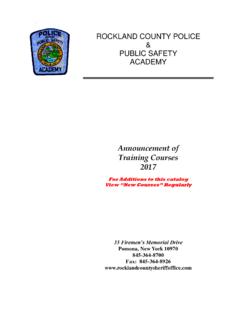Transcription of National Rifle Association
1 National Rifle Association Law enforcement Division NRA Tactical Police Competition Standards Edition NRA 2008 A Competitive Based Training Program of the NRA Law enforcement Division Note: This document is written gender neutral. The phrase his/hers , he/she are not used. The words he and his apply to both male and female competitors. The NRA Tactical Police Competition Program was created to support the Nation s law enforcement officers and in honor of our fallen comrades and their families. National Rifle Association Tactical Police Competition Standards Table of Contents SECTION 1: SECTION 2: COMPETITOR 2 2 Full Time Sworn Law 2 Full Time Certified Law enforcement firearm 2 Full Time Private Law enforcement Reserve or Auxiliary 2 Retired Law enforcement 2 Federal Flight Deck 2 Armed Forces 2 Non-US Law 2 Invitational / Shoot-with-a-Cop Shooters.
2 2 NRA 3 SECTION 3: 3 Core Safety 3 Operational Safety 3 Unloading & Cold Range Movement on the Range Safe 4 firearm 4 180 Degree Safety 4 Trigger Finger 5 Dropped 5 Negligent 5 Unsportsmanlike Hearing & Eye Protection .. 6 6 Safety: Competitors & Match Everyone s 6 Match 6 Range 6 Range 6 Edition NRA 2008 NRA Tactical Police Competition Standards Edition 2008 SECTION 4: firearm 6 General firearm & Equipment 7 Internal 7 Trigger Pull 7 Long Gun 8 8 firearm Division Requirements / 9 10 11 SECTION 5.
3 COMPETITOR 12 Handgun Holsters and 12 Handgun Magazine Shotgun Ammunition Rifle Ammunition Duty Handgun Optics (DHO) ..15 Rifle 16 Laser 16 firearm Mounted 16 Dump Grab & Go Personal Footwear & Video Recording & Photography SECTION 6: firearm OR EQUIPMENT Competitor Equipment 18 Ammunition 18 firearm 19 Disabled firearm & Substitute SECTION 7: TARGETS, SCORING & 19 NRA Tactical Police Scoring 20 Competitor Target Partially Breaking a Scoring Ring or Target Use of Scoring 21 Target Scoring Steel Targets, Frangible Targets, & Other Prop Steel 22 Frangible 22 Other Prop 22 0 0 2 4 0 Scoring .23 Procedural .24 Fail to Follow Course of Fire .24 First Shot Time Maximum Course.
4 24 Threat Target Not .24 Target .24 Hit on a Non Threat .24 Pass Through .24 Rounds Striking a Barrier and Impacting a .24 Firing Underneath a Non Threat .24 Unsportsmanlike Manual Safety .25 Disqualification From a Course of Fire or Challenges to Scoring or Assessment of SECTION 8: COURSE OF FIRE TERMS & Cease Fire Command ..26 Stop Cruiser Safe / Optics Ready Shoulder Ready Safety Circle Start Line / Firing Moving from One Firing Area to Firing from the Last Firing Course of Fire Operations & Course Shooter Ready?..31 Fire Shooter, Are You Done?..31 Shooter, Unload, Lock the Action Open & Verify Unloaded Aim at the Berm, Press the Trigger, Scan, and Shooter, do you have a claim for a We are Course Appendix 1: Course of Fire Appendix 2: Example Paper Score Sheets & Shooter Record NRA Tactical Police Competition Standards Edition 1 NRA 2008 SECTION 1: PURPOSE The NRA Law enforcement Activities Division created the Tactical Police Competition (TPC) program to encourage patrol officers to gain more experience, training and time on the range using their duty firearms.
5 While traditional standard qualification courses of fire are very important, we believe officers need additional practice time, live fire exercises, and challenges to hone their skills and gain additional experience in handling and deploying duty firearms. TPC is different in many ways from other combat or tactical competitions. Some notable differences include: TPC is only for law enforcement officers, members of the Military and private sector law enforcement officers. Firearms, holsters and other equipment must be patrol duty gear. Courses of fire are designed as either Skill Based Courses or Scenario Based Courses. Skill Based Courses challenge the officer s skills and abilities in handling, accuracy and overall proficiency with a given firearm system under set conditions.
6 Scenario Based Courses place the officer in a hypothetical law enforcement encounter. The officer must then decide how to run the course and solve the challenges presented according to their own tactics and skills. TPC matches are comprised of four to eight separate courses of fire. Courses may be handgun only, Rifle or shotgun only, or a combination of firearms. Each course is designed to challenge the officer s skills in the use of their duty firearms and equipment. Some of the challenges include: assessing threat and non-threat targets; firing from unusual shooting positions; making tactical decisions of how to move through a course; using cover and working around visual barriers; being responsible for ammunition management; assessing hits; and balancing the paramount need for accuracy with speed.
7 TPC courses of fire can be used by agencies as skill or tactical training courses simply by removing the timed scoring element. NRA Law enforcement instructor Development Schools teach Bring the street to the range. TPC is designed with a similar philosophy and where possible we attempt to have officers face the same challenges. For instance, in TPC there are no separate categories for high capacity handguns and single stack handguns, or different scoring systems for different calibers. This is because suspects on the street do not know, care or act differently because of any of these factors. If an officer carries a handgun with a capacity of only 8 rounds he should be very proficient in ammunition management, and Tactical and Speed Reloads. TPC has no equalizing formulas for calibers and does not modify courses to make them friendly to specific firearm types.
8 What an officer carries on the street should be what he uses in TPC courses. An exception to our street reality preference is the use of multiple sets of threat targets. Most law enforcement firearm related street encounters involve one or two lethal threat adversaries. If TPC matches strictly followed this statistic, officers would fire only 10 to 20 rounds during an entire day s match. While realistic in threat numbers, this is not a very efficient use of the officer s time and fails to maximize range time for practice and training. As such, in Scenario Based Courses officers will find multiple engagement decisions and sets of threat targets to provide additional opportunities for officers to practice and evaluate their skills. NRA Tactical Police Competition Standards Edition 2 NRA 2008 SECTION 2: COMPETITOR ELIGIBILITY Competitors must meet one of the eligibility requirements listed below.
9 It is the competitor s responsibility to have his law enforcement or military identification in his possession when entering and competing in NRA Tactical Police Competitions. Categories Full Time Sworn Law enforcement : Regular full time sworn public law enforcement officers, including transit police and correctional officers, of a regularly constituted law enforcement agency of a municipal, county, state, or federal government. Full Time Certified Law enforcement firearm instructor : Full time certified Law enforcement firearm Instructors employed by public law enforcement agencies, academies, or private law enforcement agencies. Full Time Private Law enforcement Officer: Individuals working as licensed, armed private security professionals, industrial police, Nuclear Security Officers, or as a contracted security officer for a private, or government agency.
10 Reserve or Auxiliary Officers: Officers of a regularly organized reserve or auxiliary unit who perform the same duties as full time public law enforcement officers, have sworn arrest powers, and are authorized to be armed. Retired Law enforcement Officers: Officers who retire and receive retirement credentials from any of the above categories. Federal Flight Deck Officers: Must possess current certification. Armed Forces Personnel: Active duty and reserve personnel serving in the United States Armed Forces or National Guard. Retired service members are eligible. NOT ELIGIBLE: Members assigned, or who have been assigned within the last 12 months, to any military marksmanship unit, such as the Army Marksmanship Unit, except as a short term student. Non-US Law enforcement : Sworn law enforcement officers from other countries with proof of identity and position.









